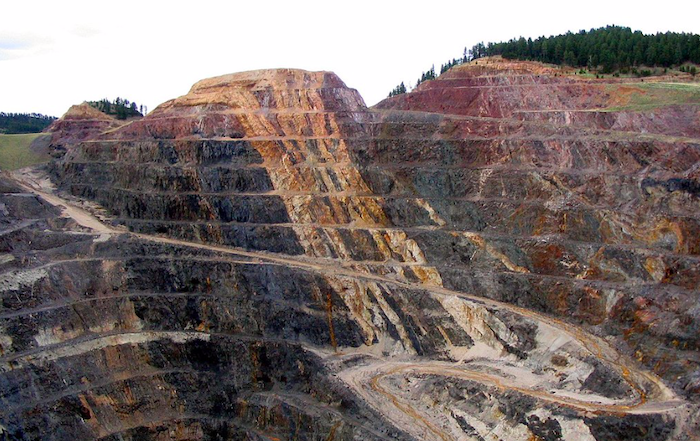
The Homestake gold mine was the largest known iron-formation-hosted gold deposit and the largest gold producer from a single deposit outside of South Africa.
The Homestake mine is located in the Whitewood mining district in Lead, Lawrence County, Western South Dakota, at the northern end of the Black Hills. The mining district is around 5,400 ft above sea level.
The Early Diggin’s
Placer gold was discovered in 1874 in French Creek, near the current village of Custer, in the southern Black Hills. Ever since this news spread out of the Black Hills, people started to flock in droves to unearth the treasure.
Another placer gold discovery was made in 1875 near Deadwood Creek, about 10 miles east of Lead. Manuel Brothers, Fred and Moses, Hank Harney, and Alexander Engh discovered the Homestake lode, the source of those placer gold, in 1876.
This marked the beginning of one of the largest gold mines in history. The original claim was sold to George Hearst in 1877, who gave it the name Homestake.
Initially, ores were mined on the surface to extract gold from mineral veins exposed on the surface. Hand-dug exploration and production trenches were made to chase the mineral veins as they ran deeper into the earth.

The Homestake Mine, South Dakota. 1889.
Tunneling Deep for Gold
By the 1890s, Homestake had already implemented some mining and milling innovations.
In 1901, the mine began using compressed air locomotives, which by the 1920s had completely replaced mules and horses.
By 1906, the Ellison Shaft had reached 1,550 feet, the B&M had reached 1,250 feet, the Golden Star had reached 1,100 feet, and the Golden Prospect had reached 900 feet, producing 1,400,000 tons of ore.
In 1907 and 1919, two devastating fires broke out at the mine, which temporarily halted operations.
Selective mining was first practiced at Homestake in the late 1920s.
By 1927, the mine had reached a depth of 3,500 feet. A second winze from the 3,500-foot level reached 4,100 feet in 1934, and a third winze from 4,100 feet was started in 1937.
In 1938, work on the Yates shaft began. Due to Limitation Order L-208 issued by the War Production Board, production halted during World War II from 1943 until 1945.
Mining started back up after the war.

A sample of the typical green schist that was mined at the Homestake Mine. Generally, ores would assay fairly low-grade at less than 1 ozt. per ton. However, the ore body was massive, allowing the mine to be actively worked for many years.
A Mile Deep and Still Digging!
Mining operations had reached a level of 6,800 feet by 1975, and two winzes to 8,000 feet were planned . By the time it was shut down, it had reached a depth of 8,000 ft below the surface.
Even though the Homestake gold ore was deemed low grade (less than one ounce per ton), the ore body was large. By 2001, the mine had produced 39,800,000 troy ounces of gold and 9,000,000 troy ounces of silver.
Shutdown of the Homestake Mine
Homestake Mine activities were terminated following the merger of Homestake Mining Company with Barrick Gold in 2001. Low gold prices, poor ore grade, and excessive expenses were among the reasons.
Homestake miners began mining using rudimentary tools such as candlesticks, mules, and hammers. By the time the mine closed, miners were using pneumatic, electrical, and hydraulic equipment. The Homestake Mine employed thousands of men and women.
Over the years, there have been nearly 400 fatal mining accidents. However, mining methods evolved. Engineering design, ground control, scheduling, and equipment all played vital roles in developing mining methods. Safety became a main priority in all Homestake Mine operations. Homestake has brought smiles and tears to the faces of thousands of people over decades. At the time of its closing, Homestake had become one of the world’s safest mines.
Extensive maintenance expenses caused Barrick Gold Corporation to turn off the dewatering pumps shortly after the Homestake Gold Mine closed.
Silencing these motors enabled the water to rise freely. It spilled across the floor of the 8000 Level, creeping up the shafts and filling one level after another. The rising water level submerged train tracks, tools, and utility lines.
However, the National Science Foundation did not want this massive man-made structure to go to waste. As a consequence, the conversion of Homestake Mine into a scientific facility became a reality. The Sanford Underground Research Facility was founded with a substantial grant from the facility’s namesake, a land donation from Barrick Gold Corporation, and the founding of the South Dakota Science and Technology Authority (SDSTA).
The Homestake mine is one of the world’s largest man-made structures.
